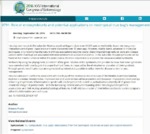Please use this identifier to cite or link to this item:
http://www.alice.cnptia.embrapa.br/alice/handle/doc/1073406| Title: | Role of endosymbionts and potential applications on neotropical true bug's management. |
| Authors: | PRADO, S. de S.  |
| Affiliation: | SIMONE DE SOUZA PRADO, CNPMA. |
| Date Issued: | 2016 |
| Citation: | In: INTERNATIONAL CONGRESS OF ENTOMOLOGY, 25., 2016, Orlando. Abstracts... Annapolis: Entomological Society of America, 2016. Ref. 0791. |
| Description: | Introduction: Insects in the suborder Heteroptera (true bugs) include over 40,000 species worldwide. Insect-microorganism interactions are of great importance and were discovered over 50 years ago. However, mainly due to advances in molecular techniques, only recently has the nature of these associations become clearer. Many important agricultural pests and disease vectors within true bugs are associated with endosymbionts in a close relationship. In this suborder, though symbionts can be found in the insect ?s lumen or within the gastric caeca, the main objective is to elucidate the caeca-associated symbionts. Methods: By using the phylogenetic placement of the gene 16S RNA of the symbionts, it is possible to show that some symbionts have coevolved with true bugs to the scope that host fitness is impacted by the elimination or alteration of their symbiont. Through genetic modification (paratrangenesis) of symbionts it is possible to utilize them for disease control or pest management. Results/Conclusion: Symbionts associated with true bugs of the neotropics including bugs of the families Acanthosomatidae, Alydidae, Coreidae, Pentatomidae, Phyrrocoridae and Scutelleridae will be presented and discussed. Phylogenetic relationships between gut symbionts of heteropteran species will also be presented, as well as, Actinobacteria diversity of 12 genera that inhabit the midgut of pentatomids. With the increasing interest and understanding of the stink bugs/endosymbiont associations, and their ecological and physiological features, it will only be a matter of time before pest/vector control programs utilize this information and technique. |
| Keywords: | Simbionte |
| Type of Material: | Resumo em anais e proceedings |
| Access: | openAccess |
| Appears in Collections: | Resumo em anais de congresso (CNPMA)  |
Files in This Item:
| File | Description | Size | Format | |
|---|---|---|---|---|
| pradorole.pdf | 185.09 kB | Adobe PDF |  View/Open |









